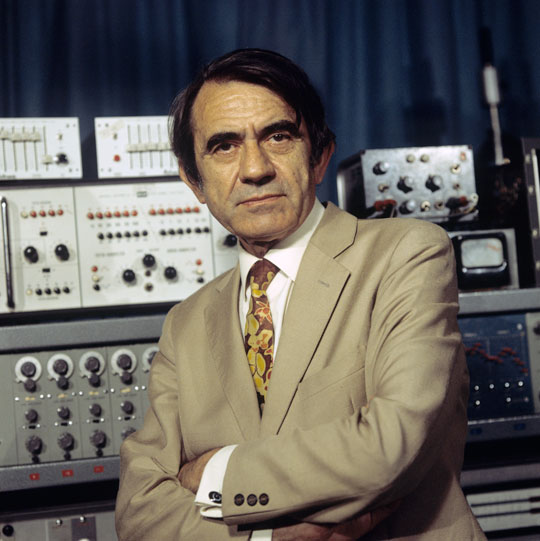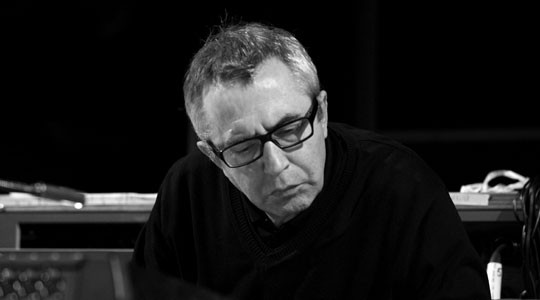Groupe des recherches musicales
INA-GRM / Recollection GRM

Founded by Pierre Schaeffer in 1958, Paris-based Groupe de recherches musicales (INA-GRM) was one of several theoretical and experimental groups operating under the umbrella of the Office de Radiodiffusion Télévision Française. Devoted to production and creation, the GRM remained based on practice, and could be summed up in the catch phrase "do and listen". Exploring Schaeffer’s ideas of musique concrète, acousmatic music, as well as other audible phenomena and music in general (including non-Western music), the GRM remains active today as a leading laboratory of sound experimentation that successfully connects to a younger generation of contemporary artists. The group has counted musicians such as Luc Ferrari, Iannis Xenakis, and the recently deceased Bernard Parmegiani among its members.
When electronic music began to emerge in the 1940s, it was quickly contrasted into two different trends – that of Cologne, called elektronische Musik (based solely on the production and manipulation of electronically produced sounds rather than recorded sounds), and that of Pierre Schaeffer, known as musique concrète; a form of electroacoustic music based on pre-existing (concrete) materials such as recorded environmental sound, but also incorporating recorded sound of electronic synthesizers, instruments or voices. In contrast to previous creation techniques, where composers first conceived music in their mind, often transmitting it via notation to performers, musique concrète compositions cannot pre-exist as ideas (the abstract), and are rather products of their constituent recorded elements.
Educated at the Paris Polytechnic as an electronics engineer, Schaeffer began to work with the Radiodiffusion Television Francaise (RTF) in 1930. More than a decade later, in 1942, he convinced the heads of the RTF to undertake acoustics research, which he proceeded to organize and manage under the name Club d’Essai, and then in 1946, the Studio d’Essai. Over the next few years the project took-in sound engineer Jacques Poullin and composer Pierre Henry, with whom Schaeffer collaborated on a number of musical works.

The 1950s were an increasingly prolific time for the studio, supporting experimentation of the nature of sound and new ways of envisioning instruments, compositional methods. Listening and perception themselves were also thoroughly explored. Central to Schaeffer’s research was the idea of acousmatic sound, that is, sound of which the source is obscured or unknown. Initially achieved by reinventing machines into instruments – for instance by using the gramophone as a means to generate unheard behaviours of sound using techniques such looping, speed variation, reversal, and removal – research into acousmatic music lead Schaeffer towards the conception of musique concrète. Such techniques allowed new sounds to be created from the original sound, masking the identification of the source. With the advent of the tape recorder at the studio, Schaeffer set to exploring the transformations of recorded objects even more elaborately.
"I have coined the term musique concrète for this commitment to compose with materials taken from ‘given’ experimental sound in order to emphasize our dependence, no longer on preconceived sound abstractions, but on sound fragments that exist in reality and that are considered as discrete and complete sound objects …" – Pierre Schaeffer announcing his discovery on 15 May 1948 (from: Schaeffer, Pierre, In Search of a Concrete Music, translated by John Dack and Christine North, University of California Press, 2012).
During the 1960s Schaeffer put together new teams for research; the Group for Technical Research focused on the development of new electronic instruments, while the Group for Image Research focused on audiovisual questions. This period led to the creation of numerous analogue instruments, synthesizers, recording devices, and a vast array of techniques in creating and performing musique concrète and acousmatic musics. Experimentors included famed composers such as Edgard Varèse, Iannis Xenakis, Francois Bayle, and Beatriz Ferreyra among others. Undergoing several name changes during this period, the research centre eventually settled with its GRM title.
The GRM was one of the first to invest in digital music technology, despite Pierre Schaeffer's extremely cautious view towards it. Schaeffer continued to stick firmly to the principles of musique concrète and expressed his scepticism towards the use of computers in music. Arguing the impossibility of making music without the help of sound material, that is, by simply writing a computer code, Schaeffer saw real time use of computers or their use as a tool to orchestrate sound material as the only opening to digital composition.
Not all of his colleagues agreed with Schaeffers’s position, leading to a break within the institute in the early 1970s. Soon after, however, the GRM re-centred its focus into adapting computer music to the needs of musique concrète. The latter 70s provided fresh winds into the institution, through the acquisition of new computer equipment via the national audiovisual office (INA), who had taken over management of the GRM hitherto entrusted to the radio service, in 1975. However the composers of the GRM did not take to the software initially as it was necessary to predetermine the data and code their musical parameters exactly. The answer to this restrictive setback was to develop digital programs that would reproduce manipulations of the analogue studio so that composers would find themselves in familiar territory. Under Jean-François Allouis, who joined the institute in the 70s, the INA-GRM advanced the development of the synthesis of music in real-time, and began to develop its first musical computer software for real-time audio signal processing. Known as the Système Temps Réel, SYTER was officially launched in 1984.

After Allouis, another arrival of great importance was that of Hugues Vinet, who spearheaded focused research into the use of new equipment such as Macintosh computers associated with Digidesign platforms and Sound Designer software in the 1990s. His GRM Tools was a package of software and utilities for sound synthesis and processing, initially launched in 1992 and developed over the subsequent decade in collaboration with Digidesign.
In 2005 the GRM launched its Presences electronique festival under current GRM programme director Christian Zanési. The festival continues to run yearly in early spring. The current general director of INA-GRM is Daniel Teruggi.
INA-GRM Records and Archives
Works created under the INA-GRM (or its various historical names) have been published since 1978 with the launch of sublabels Collection GRM (until 1978) and Série Gramme (until 1983), both directed by then head of the INA-GRM, François Bayle. L’Acousmathèque, the GRM library in charge of the preservation of more than 5,000 tapes from 1500 works recorded since 1948 by more than 200 different composers, was launched in 1993, and constitutes another of the GRM’s sublabels.
Since 2012, a substantive body of work from the organizations archives continues to be revived through the Recollection GRM sublabel of Editions Mego. The GRM showcase at CTM 2014 is presented as part of a wider focus on Editions Mego at the festival.


